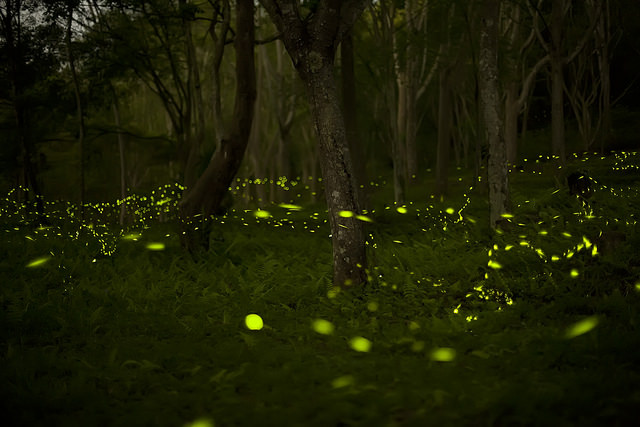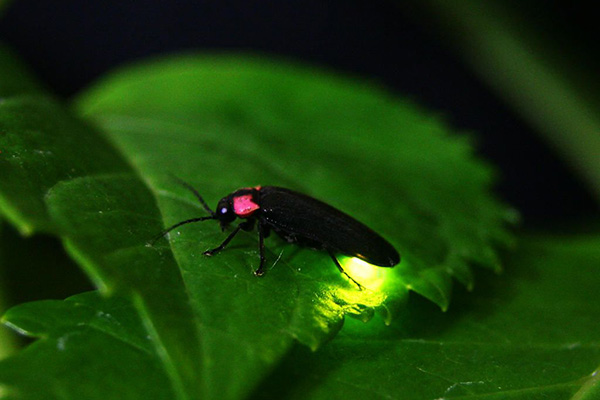
Fireflies, they are indispensable items of the early summer sight of Japan. They used to be found everywhere near water decades ago. But the population of fireflies has dropped and they can be seen only at limited places in recent years. You might think there is no longer a chance to see wild fireflies as long as you live in Tokyo area, but actually there are a few places you can view fireflies within Kanto region. So, why not go out on a train to see beautiful glow of fireflies and enjoy an early summer evening.
About fireflies

photo by togarionsen
The fireflies are a family of insects in the beetle order Coleoptera. Some genus of them are known for emitting faint light from the lower abdomen to attract mates and prey. Thousands of glowing yellowish lights created by mobs of male and female fireflies attracting each other have been the most favored summer view of the Japanese since the old time. There are so many poems about fireflies in great Japanese literatures such as “Man’yoshu” the oldest anthology of “waka” poems, “The Pillow Book (Makura-no-Sohsi)” and “The Tale of Genji (Genji Monogatari)” from Heian period. The number of firefly genus recognized in Japan is between 40 to 50, but “Genji-botaru (Luciola cruciate)” and “Heike-boraru (Luciola lateralis)” are most known fireflies of Japan. “Genji-botaru“ has longer body and produces brighter light than “Heike-botaru”. Fireflies are often seen around the grass beside the water as the larvae feed a specific species of freshwater snail called “kawanina”. After the eggs hatch, the larvae spend about a year in the water until they emerge as adults. Adult fireflies generally feed only nightly dew and end their short lives after mating to produce offspring. They have only 1-2 weeks to live after they emerge as adults and start flying around.
The best time of year to see the fireflies
Fireflies are generally seen between late May and late June. Just like “cherry blossom front”, there is a term “firefly front” which describes the best season for firefly watching. It starts from warm climate southern part of the country and gradually moves up north in later time. As for the types of fireflies, “Genji-botaru“ turn up first, then “Heike-botaru” start to appear. WHEATHERNEWS publishes useful “Online firefly info” every year to provide updated information and reports from all parts of the country. Also, whether the appearance of fireflies is very much affected by weather of each day, even within the best season. Fireflies only fly and glow under the certain weather condition: between 8:00PM and 9:00PM on a cloudy, humid and calm weather day is the best day for firefly viewing. Give it a raincheck if the weather is windy or rainy as you won’t expect many fireflies.
Firefly watching Do’s and Don’ts
Don’t try to catch fireflies
Catching and taking fireflies is strictly prohibited. Just quietly enjoy the genuine beauty of the faint glow of fireflies in the nature.
Don’t use bright light
Avoid using a torch, headlights or hazard lights of a car and any other bright lights. Fireflies stop glowing where bright lights are present.
Keep the site clean and tidy
Fireflies cannot live in contaminated water. Do not leave any wastes and do not smoke on the site. Also, avoid trampling the grass on riverbanks under foot.
Mind using anti-insect agents
A bug spray and pyrethrum coils might be a must-have item when going out on muggy evenings. But wait a minute, fireflies are INSECTS. Anti-insect agents definitely affect them. If you wish to avoid contacts of other insects, simply cover your body with long sleeves and trousers.
Firefly watching destination in Kanto 1: Itsukushima Shissei Park (Kanagawa)
Located in Nakai-machi Kanagawa prefecture, Itsukushima Shissei Park is designed to protect the palustrine created by spring waters and wild lives inhabit there. Other than fireflies, many scarce water creatures can be found here as well as seasonal plants and flowers growing along the footpaths. During the bamboo lantern evening event, which is held around the end of May every year, 3,000 bamboo lantern lights entertains visitors together with thousands of glows dancing in the air. Also, another firefly watching place “Firefly Park” is just 1km away.
Itsukushima Shissei Park (Japanese site)
Address: 1310 Inokuchi, Nakai-cho, Ashigarakami-gun, Kanagawa
Access: Bus from Odakyu Hatano station, or JR Ninomiya station
Firefly watching destination in Kanto 2: Izumiya Park (Chiba)
Izumiya Park in Midori-ku Chiba is a general recreation park with open grass area, iris garden, pond and more. The breeding program is operated in the firefly biology area. Between late May and the end of June, artificially bred “Genji-botaru” are released nearby ponds and water passages in the park to welcome visitors. In the lecture room, educational materials are displayed; photo panels explaining a life of firefly and the breeding room. Footpaths are illuminated with handmade bamboo candles for 2days in early June as a special event.
Izumiya Park
Address: 6-11 Oyumi-no Chuo, Midori-ku, Chiba-shi, Chiba
Access: Wa-lk or bus from JR Kamatori station
Firefly watching destination in Kanto 3: Fussa Firefly Park (Tokyo)
Fussa city is a very rare firefly viewing place in Tokyo with lots of green, just 80munites’ away from Tokyo station by train. About 500 fireflies are released and soar freely in the air during “Fussa Firefly Festival” June every year. During the festival, the drumming performance and dancing performances entertain visitors as well as stalls held around the site. Fireflies can be spotted for about a week after the event.
Fussa Hotaru Park (Japanese site)
Address: 3-9-1 Minemi Den-en, Fussa-shi Tokyo
Access: JR Kumagawa station or Ushihama station
The faint glow remained, just beyond my grasp
Fireflies, such a fragile lives capable to live under the unspoiled nature with pure water and rich green. Maybe it is their short lasting glow of lives that attracts us most. Just by watching little faint firefly glows in the great nature, you will be detoxed all over yourself. It would be a great refreshment during the rainy season.
